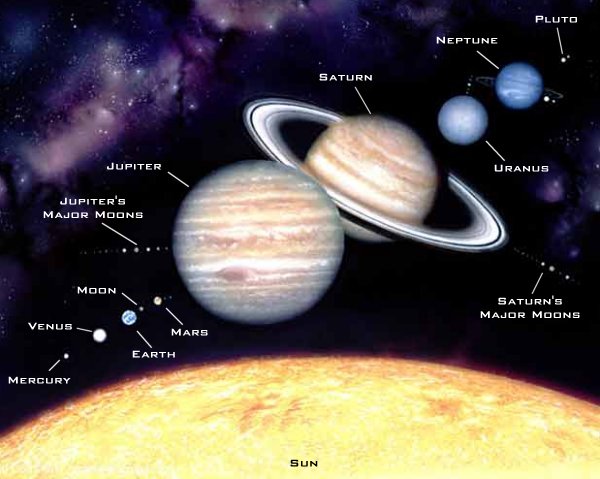|
||||||||||
|
|
||||||||||
|
||||||||||
|
|
||||||||||
The value of G is a constant that should not change no matter where one is in the universe. The value of g, however, does vary for each planet, star, moon, or other large body based on its size and mass. These two gravitational parameters are related by the equation:
where
RE = 6.375 x 106 m in the Metric system
RE = 2.091 x 107 ft in the English system

When we do so, we find that the Earth's acceleration due to gravity is indeed about 9.81 m/s².

We can go even further by using this relationship to solve for the acceleration due to gravity on other planets or moons. The following table provides the mass, radius, and gravitational acceleration of several major bodies within our solar system.
| Acceleration Due to Gravity Comparison | ||||
|---|---|---|---|---|
| Body | Mass [kg] | Radius [m] |
Acceleration Due to Gravity, "g" [m/s²] |
g / g-Earth |
| Sun |
|
|
274.13 | 27.95 |
| Mercury |
|
|
3.59 | 0.37 |
| Venus |
|
|
8.87 | 0.90 |
| Earth |
|
|
9.81 | 1.00 |
| Moon |
|
|
1.62 | 0.17 |
| Mars |
|
|
3.77 | 0.38 |
| Jupiter |
|
|
25.95 | 2.65 |
| Saturn |
|
|
11.08 | 1.13 |
| Uranus |
|
|
10.67 | 1.09 |
| Neptune |
|
|
14.07 | 1.43 |
| Pluto |
|
|
0.42 | 0.04 |
The last column of the table compares the acceleration due to gravity of the body to that of Earth. A small body like the Moon only exerts a gravitational acceleration about 1/6th as strong as that of Earth while the massive Sun generates an acceleration nearly 28 times that of Earth. Tiny Pluto, meanwhile, only exerts about 4% the gravity of Earth.
This information is also useful since it directly corresponds to how much an object would weigh on the surface of each of these bodies. We have previously discussed the relationship between weight, mass, and gravity in a number of articles. As we have seen, the mass of an object remains constant whether it is on the surface of Earth, the surface of the Moon, or in the depths of space. The quantity that does change depending on the strength of the gravitational field is the object's weight. These variables are related by the equation:
where
Another place in the solar system humans are likely to visit in the future is Mars. Although Mars is the planet
most like Earth in terms of its environment, the gravitational acceleration on this much smaller planet is only
about 40% that of Earth. Mars is also farther from the Sun and takes longer to complete an orbit, so a Martian
year is about twice as long as a year on Earth. On this Mother's Day, you might consider offering the women in
your life a trip to the distant red planet. After all, what woman wouldn't like the idea of having her weight and
age cut in half?!
- answer by Joe Yoon, 8 May 2005
Read More Articles:


|
Aircraft | Design | Ask Us | Shop | Search |

|
|
| About Us | Contact Us | Copyright © 1997- | |||
|
|
|||